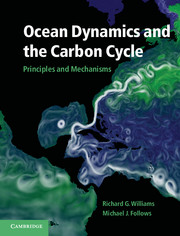Book contents
- Frontmatter
- Contents
- Preface
- Acknowledgements
- Illustration credits
- Part I Introduction
- 1 Why is the ocean important?
- 2 An introductory view of the ocean
- Part II Fundamentals
- Part III Physical Phenomena and their Biogeochemical Signals
- Part IV Synthesis
- Appendix
- Symbols and definitions
- Glossary
- Answers
- References
- Index
- Plate section
2 - An introductory view of the ocean
from Part I - Introduction
Published online by Cambridge University Press: 05 June 2012
- Frontmatter
- Contents
- Preface
- Acknowledgements
- Illustration credits
- Part I Introduction
- 1 Why is the ocean important?
- 2 An introductory view of the ocean
- Part II Fundamentals
- Part III Physical Phenomena and their Biogeochemical Signals
- Part IV Synthesis
- Appendix
- Symbols and definitions
- Glossary
- Answers
- References
- Index
- Plate section
Summary
Many aspects of the ocean are challenging to understand, including how the ocean stores and redistributes heat over the globe, how life has colonised the ocean and how carbon is cycled between the ocean, atmosphere and land. To answer these questions, we need to adopt a holistic view to understand the relevant physical, chemical and biological processes, and how they are connected to each other. For example, a western boundary current, like the Gulf Stream, has a range of signatures: a rapid transfer of heat, nutrients and carbon along the current, enhanced contrasts in physical, chemical and biological properties across the current, and increased exchanges of heat, moisture and dissolved gases with the overlying atmosphere.
A difficulty in understanding the ocean, as compared to the atmosphere, is the problem of taking observations due to the ocean being a more inaccessible and hostile environment. To counter that difficulty, a range of different techniques have been developed to unravel how the ocean circulates, drawing on a combination of ship-based measurements, remote sensing from space and freely drifting floats spreading throughout the ocean.
In this chapter, we provide an introductory view of the large-scale ocean circulation, and basic property distributions (Plates 2 to 7), as well as briefly introduce the atmospheric circulation, and then discuss how life flourishes in the ocean and, finally, how carbon is cycled in the ocean. This material provides a starting point for the rest of the book.
- Type
- Chapter
- Information
- Ocean Dynamics and the Carbon CyclePrinciples and Mechanisms, pp. 17 - 40Publisher: Cambridge University PressPrint publication year: 2011



